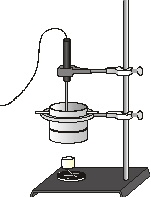Energy Content of Foods
All human activity requires “burning” food for energy. In this experiment, you will determine the energy released (in kJ/g) as various foods, such as cashews, marshmallows, peanuts, and popcorn, burn. You will look for patterns in the amounts of energy released during burning of the different foods.
OBJECTIVES
In this experiment, you will
• Determine the energy released from various foods as they burn.
• Look for patterns in the amounts of energy released during burning of different foods.

Figure 1
MATERIALS
LabQuest |
2 stirring rods |
LabQuest App |
ring stand and 10 cm (4 inch) ring |
Temperature Probe |
100 mL graduated cylinder |
2 food samples |
small can |
food holder |
cold water |
wooden splint |
matches |
utility clamp |
|
PROCEDURE
1. Obtain and wear goggles.
2. Connect the Temperature Probe to LabQuest and choose New from the File menu. If you have an older sensor that does not auto-ID, manually set up the sensor.
3. On the Meter screen, tap Rate. Change the data-collection rate to 0.5 sample/second (interval of 2 seconds/sample) and the data-collection length to 600 seconds. Data collection will last 10 minutes. Select OK.
4. Obtain a piece of one of the two foods assigned to you and a food holder like the one shown in Figure 1. Find and record the initial mass of the food sample and food holder. CAUTION: Do not eat or drink in the laboratory.
5. Determine and record the mass of an empty can. Add 50 mL of cold water to the can. Obtain the cold water from your teacher. Determine and record the mass of the can and water.
6. Set up the apparatus as shown in Figure 1. Use a ring and stirring rod to suspend the can about 2.5 cm (1 inch) above the food sample. Use a utility clamp to suspend the Temperature Probe in the water. The probe should not touch the bottom of the can. Remember: The Temperature Probe must be in the water for at least 30 seconds before you do Step 7.
7. Start data collection. Record the initial temperature of the water, t1, in your data table. Note: You can monitor temperature to the right of the real-time graph displayed on the screen. Remove the food sample from under the can and use a wooden splint to light it. Quickly place the burning food sample directly under the center of the can. Allow the water to be heated until the food sample stops burning. CAUTION: Keep hair and clothing away from open flames.
8. Continue stirring the water until the temperature stops rising. Record this maximum temperature, t2. Data collection will stop after 10 minutes (or stop before 10 minutes has elapsed).
9. Determine and record the final mass of the food sample and food holder.
10. To confirm the initial (t1) and final (t2) values you recorded earlier, examine the data points along the curve on the displayed graph. As you tap each data point, the temperature and time values are displayed to the right of the graph.
11. Repeat Steps 4–10 for the second food sample. Use a new 50 mL portion of cold water.
12. When you are done, place burned food, used matches, and partially-burned wooden splints in the container provided by the teacher.
Processing the data
1. Find the mass of water heated for each sample.
2. Find the change in temperature of the water, ∆t, for each sample.
3. Calculate the heat absorbed by the water, q, using the equation
q = Cp•m•∆t
where q is heat, Cp is the specific heat capacity, m is the mass of water, and ∆t is the change in temperature. For water, Cp is 4.18 J/g°C. Change your final answer to kJ.
4. Find the mass (in g) of each food sample burned.
5. Use the results of Steps 3 and 4 to calculate the energy content (in kJ/g) of each food sample.
6. Record your results and the results of other groups in the Class Results Table. Which food had the highest energy content? The lowest energy content?
7. Food energy is often expressed in a unit called a Calorie. There are 4.18 kJ in one Calorie. Based on the class average for peanuts, calculate the number of Calories in a 50 g package of peanuts.
8. Two of the foods in the experiment have a high fat content (peanuts and cashews) and two have a high carbohydrate content (marshmallows and popcorn). From your results, what generalization can you make about the relative energy content of fats and carbohydrates?
DATA and calculations
Food type |
|
|
Initial mass of food and holder |
g |
g |
Final mass of food and holder |
g |
g |
Mass of food burned |
g |
g |
Mass of can and water |
g |
g |
Mass of empty can |
g |
g |
Mass of water heated |
g |
g |
Final temperature, t2 |
°C |
°C |
Initial temperature, t1 |
°C |
°C |
Temperature change, ∆t |
°C |
°C |
Heat, q |
kJ |
kJ |
Energy content in kJ/g |
kJ/g |
kJ/g |
Class Results
Marshmallows |
Peanuts |
Cashews |
Popcorn |
kJ/g |
kJ/g |
kJ/g |
kJ/g |
kJ/g |
kJ/g |
kJ/g |
kJ/g |
kJ/g |
kJ/g |
kJ/g |
kJ/g |
kJ/g |
kJ/g |
kJ/g |
kJ/g |
kJ/g |
kJ/g |
kJ/g |
kJ/g |
Average for Each Food Type
kJ/g |
kJ/g |
kJ/g |
kJ/g |